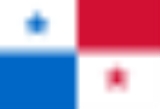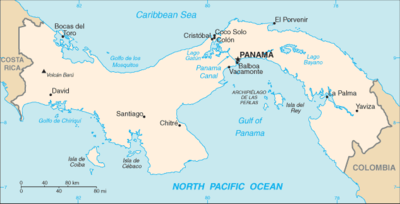
Water supply and sanitation in Panama
Encyclopedia
| Panama Panama Panama , officially the Republic of Panama , is the southernmost country of Central America. Situated on the isthmus connecting North and South America, it is bordered by Costa Rica to the northwest, Colombia to the southeast, the Caribbean Sea to the north and the Pacific Ocean to the south. The... : Water and Sanitation |
||
|---|---|---|
 |
||
| Data | ||
| Water coverage (broad definition) | 90% | |
| Sanitation coverage (broad definition) | 73% | |
| Continuity of supply (%) | High | |
| Average urban water use (l/c/d) | n/a | |
| Average urban water tariff (US$/m3) | n/a | |
| Share of household metering | 51% (2006) | |
| Share of collected wastewater treated | Low | |
| Annual investment in WSS | High | |
| Share of self-financing by utilities | nil | |
| Share of tax-financing | High | |
| Share of external financing | Low | |
| Institutions | ||
| Decentralization to municipalities | Very limited (one municipality) | |
| National water and sanitation company | Yes: IDAAN | |
| Water and sanitation regulator | Yes: ANSP (multi-sectoral) | |
| Responsibility for policy setting | Ministry of Health | |
| Sector law | Yes (1997) | |
| Number of urban service providers | 2: IDAAN and Boquete | |
| Number of rural service providers | 3,300 | |
Water supply
Water supply
Water supply is the provision of water by public utilities, commercial organisations, community endeavours or by individuals, usually via a system of pumps and pipes...
and sanitation
Sanitation
Sanitation is the hygienic means of promoting health through prevention of human contact with the hazards of wastes. Hazards can be either physical, microbiological, biological or chemical agents of disease. Wastes that can cause health problems are human and animal feces, solid wastes, domestic...
in Panama
Panama
Panama , officially the Republic of Panama , is the southernmost country of Central America. Situated on the isthmus connecting North and South America, it is bordered by Costa Rica to the northwest, Colombia to the southeast, the Caribbean Sea to the north and the Pacific Ocean to the south. The...
is characterized by relatively high levels of access compared to other Latin American countries. However, challenges remain especially in rural areas.
Access
According to the Ministry of Health, in 2006 97% had access to potable water and also 97% had access to at least basic sanitation. However, WHOWho
Who may refer to:* Who , an English-language pronoun* who , a Unix command* Who?, one of the Five Ws in journalism- Art and entertainment :* Who? , a 1958 novel by Algis Budrys...
's and UNICEF's Joint Monitoring Program/2006 estimates access to improved water supply in 2004 at 99% in urban areas and 79% in rural areas, while access to improved sanitation was 89% in urban areas and 54% in rural areas, as shown in the table below.
| Urban (57% of the population) | Rural (43% of the population) | Total | ||
|---|---|---|---|---|
| Water | Broad definition | 99% | 79% | 90% |
| House connections | 96% | 72% | 86% | |
| Sanitation | Broad definition | 89% | 51% | 73% |
Source: Joint Monitoring Program WHO
Who
Who may refer to:* Who , an English-language pronoun* who , a Unix command* Who?, one of the Five Ws in journalism- Art and entertainment :* Who? , a 1958 novel by Algis Budrys...
/UNICEF(JMP/2006).
Compared to the data of 1990, there is no significant change neither in water supply nor in sanitation coverage both in urban and rural areas.
Service quality
Despite a lack of statistical data about water quality and continuity of supply, potable water is perceived to be of good quality in Panama and most users receive continuous service.Responsibility for water supply and sanitation
Responsibilities for the sector are allocated by the Panamanian Water Law, which was approved in 1997.
Policy and Regulation
The Panamanian Health Ministry is responsible for defining the sector's policy, whereas the Autoridad Nacional de Servicios Públicos (ANSP) or National Authority for Public Services acts as regulatory agency.Responsibility for water resources is vested in two institutions: The Autoridad Nacional del Ambiente or National Environment Authority and the Autoridad del Canal de Panamá or Panama Canal Authority.
Service Provision
According to the Water Law, the Instituto de Acueductos y Alcantaeillados Nacional (IDAAN) is responsible for water and sanitation services in urban areas with more than 1,500 inhabitants, thus preventing decentralization to municipalities. The only exception is the municipality of BoqueteBoquete
Boquete is a small town on the Caldera River, tucked into the green mountain highlands of Panama, in western-most Chiriquí Province, about 60 km. from the border with Costa Rica. Because of its altitude, some 1,200 metres above sea level, its climate is cooler than that of the lowlands...
, which manages ist own water supply and sanitation system.
There are approximately 3,300 water supply systems in rural areas, of which 1,800 are managed by Juntas Administrativas de Acueductos Rurales (JAARs) or Rural Water Boards. The remaining are managed by Health Committees.
History and Recent Developments
IDAAN was created in 1961 and was made responsible for investments in water supply in urban areas and a significant increase in coverage of potable water and - to a lesser extent - sanitation. The institution disposed of high financial capacities and human resources during its first decades. However, IDAAN's financial situation deteriorated significantly due the absence of any tariff increase until 1982.
Privatization was abandoned until a change of government in 1999. Under Mireya Moscoso
Mireya Moscoso
Mireya Elisa Moscoso Rodríguez de Arias is a Panamanian political figure. She was the President of Panama from 1999 to 2004, representing the Arnulfista Party...
's administration, Law 77 was approved to modify the Water Law, permitting privatization and strengthening IDAAN. To significantly increase IDAAN's investments in urban areas, the government decided in 2003 to use financial resources earned through the telecommunication and electricity companies' privatization.
In 2006, the government of Martín Torrijos
Martín Torrijos
Martín Erasto Torrijos Espino is a Panamanian politician and the former President of the Republic of Panama.Torrijos was elected President on May 2, 2004...
established the Programa de Desarrollo Comunitario para Infraestructura Pública (PRODEC) or Community Development for Public Infrastructure Program (see below).
Tariffs and cost recovery
Neither the tariffs of IDAAN, nor rural tariffs are sufficiently high to cover investment costs. The tariff structure does not provide incentives to save water. Since half of urban and almost all rural users don't dispose of water meters, those user do not receive bills based on consumption. In addition, even those who have meters pay a fixed tariff for the first 10,000 gallons each month, which is included in the basic residential tariff.Investment and Financing
In 2005, IDAAN invested US$49m in urban areas. FIS and MINSA invested a much lower amount in rural areas. The bulk of investments was in water supply, while much less was invested in sanitation.PRODEC aims at investing US$100m of the Panama Canal's gains into community infrastructure, including water supply and sanitation. The use of these funds is decided on a participatory basis through consultative councils at the local level.
Furthermore, the National Investment Fund invests in potable water, in particular in rural areas.
External Support
The World Bank supports the sector through a US$32m loan for the Water Supply and Sanitation in Low-Income Communities Project which is executed by the Ministry of Health.The Interamerican Development Bank (IDB) supports the sector through various projects. The US$45m Panama City and Bay of Panama Sanitation Project, approved in 2006 and executed by the Ministry of Health, supports the extension of the capital's sanitation network. The sustainable development projects in Darién Province
Darién Province
Darién is a province in eastern Panama. It is also the largest province in Panama. It is hot, humid, heavily forested, and sparsely populated, having 48,378 habitants...
and Bocas del Toro Province
Bocas del Toro Province
Bocas del Toro is a province of Panama. Its extension is 4,643.9 square kilometers comprising the mainland and nine main islands. The province consists of the Bocas del Toro Archipelago, Bahía Almirante , Laguna de Chiriquí , and adjacent mainland. The capital is the city of Bocas del Toro on Isla...
include support of water supply and sanitation systems.
The Japanese Overseas Economic Cooperation Fund (OECF) supports sanitation in the city and the bay of Panama through a loan for constructing a sewage plant.
The European Investment Bank
European Investment Bank
The European Investment Bank is the European Union's long-term lending institution established in 1958 under the Treaty of Rome. A policy-driven bank, the EIB supports the EU’s priority objectives, especially European integration and the development of economically weak regions...
(EIB) approved a loan to support sanitation in Panama City in 2007.
Sources
- IDAAN, Statistical Bulletin 2006 (in Spanish)
- World Bank: Panama Public Expenditure Review, 2006
External links
- Ministry of Health (Spanish)
- National Agency for Public Services (Spanish)
- IDAAN (Spanish)
- Panama Canal Authority
- Environmental Authority ANAM (Spanish)
- Association of Regulatory Agencies for Water Supply and Sanitation -ADERASA (in Spanish)
- Global Water Partnership:Guillermo Castro H.:Panama - The Management of the Panama Canal Watershed
- Global Water Partnership:Genoveva Quintero:Panama: Restoration and integrated management in the Zaratí river sub basin

